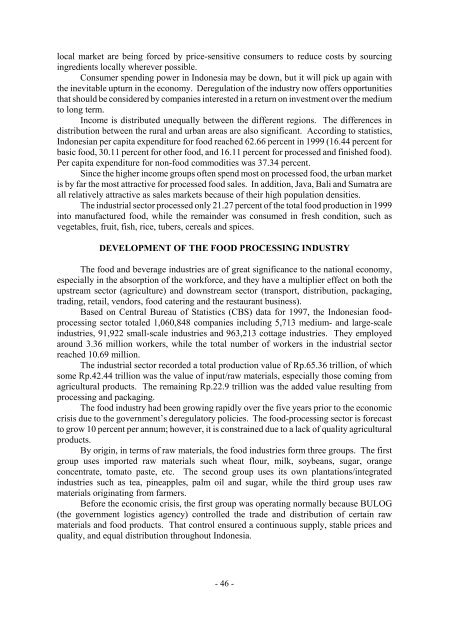Development of Agribusiness Enterprises - Asian Productivity ...
Development of Agribusiness Enterprises - Asian Productivity ...
Development of Agribusiness Enterprises - Asian Productivity ...
You also want an ePaper? Increase the reach of your titles
YUMPU automatically turns print PDFs into web optimized ePapers that Google loves.
local market are being forced by price-sensitive consumers to reduce costs by sourcing<br />
ingredients locally wherever possible.<br />
Consumer spending power in Indonesia may be down, but it will pick up again with<br />
the inevitable upturn in the economy. Deregulation <strong>of</strong> the industry now <strong>of</strong>fers opportunities<br />
that should be considered by companies interested in a return on investment over the medium<br />
to long term.<br />
Income is distributed unequally between the different regions. The differences in<br />
distribution between the rural and urban areas are also significant. According to statistics,<br />
Indonesian per capita expenditure for food reached 62.66 percent in 1999 (16.44 percent for<br />
basic food, 30.11 percent for other food, and 16.11 percent for processed and finished food).<br />
Per capita expenditure for non-food commodities was 37.34 percent.<br />
Since the higher income groups <strong>of</strong>ten spend most on processed food, the urban market<br />
is by far the most attractive for processed food sales. In addition, Java, Bali and Sumatra are<br />
all relatively attractive as sales markets because <strong>of</strong> their high population densities.<br />
The industrial sector processed only 21.27 percent <strong>of</strong> the total food production in 1999<br />
into manufactured food, while the remainder was consumed in fresh condition, such as<br />
vegetables, fruit, fish, rice, tubers, cereals and spices.<br />
DEVELOPMENT OF THE FOOD PROCESSING INDUSTRY<br />
The food and beverage industries are <strong>of</strong> great significance to the national economy,<br />
especially in the absorption <strong>of</strong> the workforce, and they have a multiplier effect on both the<br />
upstream sector (agriculture) and downstream sector (transport, distribution, packaging,<br />
trading, retail, vendors, food catering and the restaurant business).<br />
Based on Central Bureau <strong>of</strong> Statistics (CBS) data for 1997, the Indonesian foodprocessing<br />
sector totaled 1,060,848 companies including 5,713 medium- and large-scale<br />
industries, 91,922 small-scale industries and 963,213 cottage industries. They employed<br />
around 3.36 million workers, while the total number <strong>of</strong> workers in the industrial sector<br />
reached 10.69 million.<br />
The industrial sector recorded a total production value <strong>of</strong> Rp.65.36 trillion, <strong>of</strong> which<br />
some Rp.42.44 trillion was the value <strong>of</strong> input/raw materials, especially those coming from<br />
agricultural products. The remaining Rp.22.9 trillion was the added value resulting from<br />
processing and packaging.<br />
The food industry had been growing rapidly over the five years prior to the economic<br />
crisis due to the government’s deregulatory policies. The food-processing sector is forecast<br />
to grow 10 percent per annum; however, it is constrained due to a lack <strong>of</strong> quality agricultural<br />
products.<br />
By origin, in terms <strong>of</strong> raw materials, the food industries form three groups. The first<br />
group uses imported raw materials such wheat flour, milk, soybeans, sugar, orange<br />
concentrate, tomato paste, etc. The second group uses its own plantations/integrated<br />
industries such as tea, pineapples, palm oil and sugar, while the third group uses raw<br />
materials originating from farmers.<br />
Before the economic crisis, the first group was operating normally because BULOG<br />
(the government logistics agency) controlled the trade and distribution <strong>of</strong> certain raw<br />
materials and food products. That control ensured a continuous supply, stable prices and<br />
quality, and equal distribution throughout Indonesia.<br />
- 46 -
















